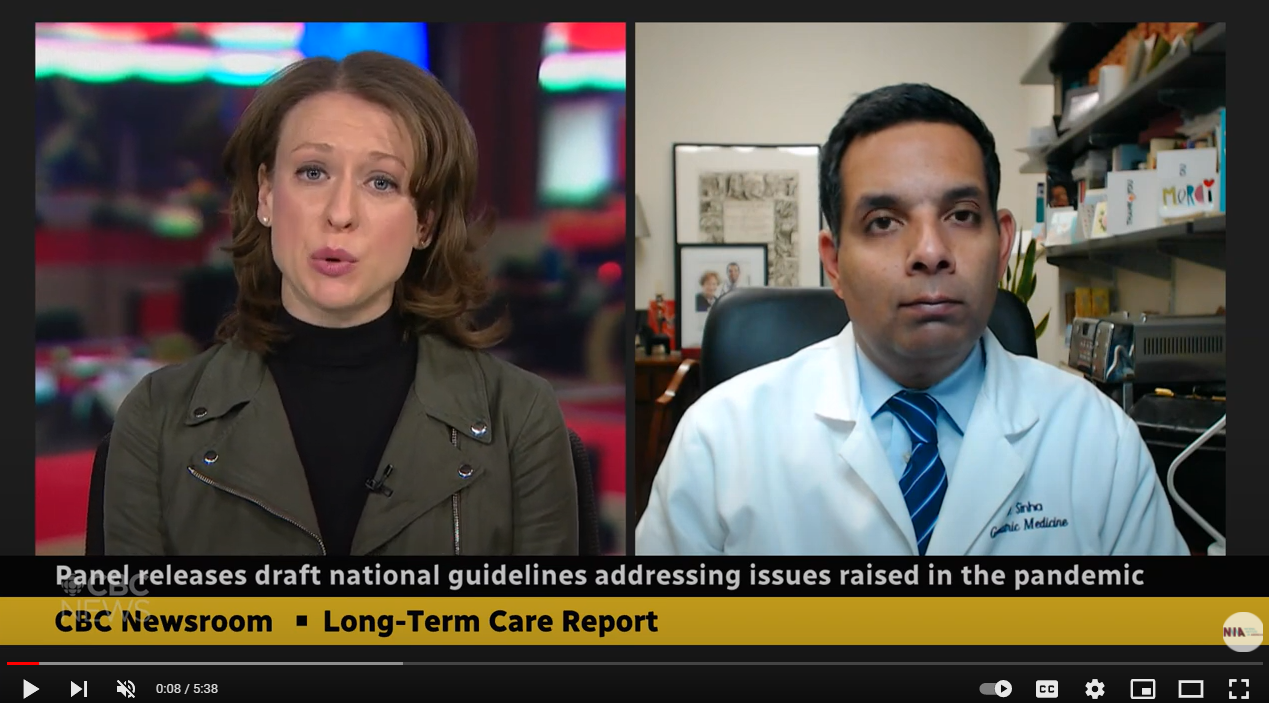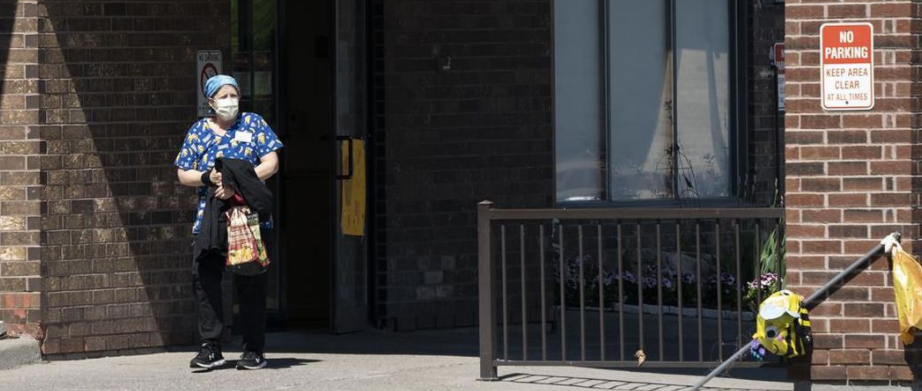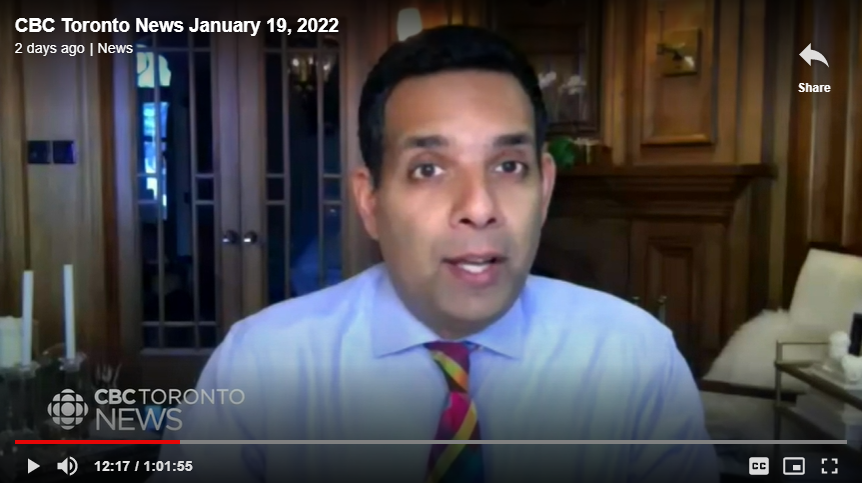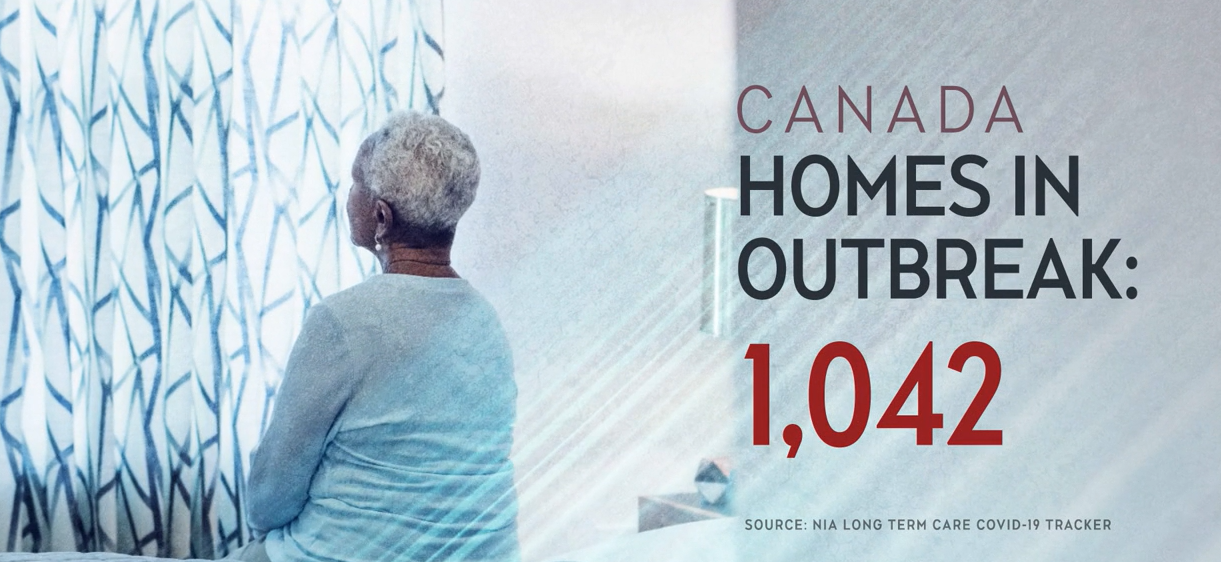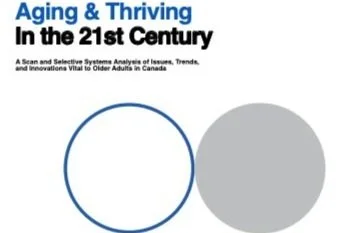"We just made history by having more than 16,000 people die in our long-term care and retirement homes because of this pandemic. Wave after wave we continue to see record numbers of homes entering outbreak. We've got some fundamental, long-standing issues that we really need to address. This became an opportunity for us to take a look at what the existing standards are that led us into this mess in the first place and what can we do to strengthen them so that they speak to what resident-centred care really looks like," says Dr. Samir Sinha, NIA Director of Health Policy Research (starts at minute 24).
Special to Financial Post by Bonnie-Jeanne MacDonald, NIA Director of Financial Security Research: By 2050 the costs of long-term care will take up more than a quarter of all income tax revenues
Dr. Samir Sinha, HSO’s long-term care services technical committee chair, said he is hopeful this will provide a “clear blueprint” to enable the federal government, provinces and territories to move long-term care “to where all Canadians are demanding it to go.”
"I'm hoping. My God, I'm hoping that this will be a clear blueprint that really can enable provincial and territorial and federal action to move long-term care to where all Canadians are demanding it to go," said Dr. Samir Sinha, NIA Director of Health Policy Research.
"Thousands of Canadians said, 'We want long-term care to feel like home to be home-like.' So we asked, 'What does that mean to you?' The standard can become the basis for new legislation for new regulations," says Dr. Samir Sinha, NIA Director of Health Policy Research.
“If you want to enable the standard, you have to fix issues of funding. You must have better staffing. We must have better levels of accountability,” says Dr. Samir Sinha, NIA Director of Health Policy Research.
"The previous standards didn't have much to say about the [long-term care] workforce. But we know that our conditions of work are the conditions of care. And unless we actually make sure we have a well supported, resilient and competent workforce, then you can't even provide good care at all," says Dr. Samir Sinha, NIA Director of Health Policy Research.
“I think a lot of the standard has been written in that line of thinking, about what have we experienced and what further things we need to do in the standard to have avoided a lot of what we had been witnessing over and over again during this pandemic,” Dr. Samir Sinha said in a media briefing ahead of the document’s release.
“These standards can be so much more than just the basis of accreditation programs,” said Dr. Samir Sinha, NIA Director of Health Policy Research.
"I'm hoping that this will be a clear blueprint that really can enable provincial, territorial and federal action to move long-term care to where all Canadians are demanding it to go," said Dr. Samir Sinha, NIA Director of Health Policy Research.
"Once you have that framework in mind, it is actually pretty easy to start framing everything else in a way that respects the rights of residents," says NIA Director of Health Policy Research, Dr. Samir Sinha.
You should still get a booster even if you’ve just had COVID, according to Dr. Samir Sinha, NIA Director of Health Policy Research. Dr. Sinha recommends getting a booster – or even a fourth shot if eligible.
“We don’t know how strong your level of natural immunity will be in response to a recent infection with COVID. And we don’t necessarily know how long it will last,” Sinha tells Global News.
How can you bring up peri- or menopausal issues with a manager who you don’t think will be supportive?
"When deciding how to approach this with your employer, it’s important to first consider what kind of workplace you are in. Some organizations have fostered cultures where you can have all kinds of open conversations. Other organizations don’t have that type of open culture, so when you encounter an issue – whether it’s menopause or another wellness-related health issue – those conversations can become really difficult," said Lisa Taylor, NIA Associate Fellow and Founder and President at Challenge Factory.
NIA Director of Health Policy Research, Dr. Samir Sinha, says there was already a shortage of staff in long-term care homes across the province. "Right now, two years into the pandemic, we just don't have the resilience in our system in terms of the adequate amount of staff and supports that we can actually provide in a crisis."
"Sometimes children of elderly parents bully them into giving up driving," says Dr. Samir Sinha, NIA Director of Health Policy Research. Rather than having a family member shut down driving, he recommends a thorough conversation with the person who is driving to determine their driving fitness and views around driving.
“This is the highest number we have ever had, and we haven’t even reached the peak,” Dr. Samir Sinha, NIA Director of Health Policy Research, said in an interview. “It’s the ultimate letdown to have one of the government’s smartest ministers put in charge of tackling this file resign on a day when Ontario has never seen so many long-term care homes in a COVID-19 outbreak.”
If Toronto succeeds with its plans to transform all city-operated nursing homes, it will become a North American municipal leader in long-term care, said Dr. Samir Sinha, co-chair of Toronto’s seniors’ accountability group and NIA Director of Health Policy Research.
Sinha said the city has a seniors strategy that elevated community support for older adults and focused on long-term care. Still, he said, the possibility of extra staff in nursing homes does not immediately mean Toronto will succeed with high-quality emotion-centred care.
"What we've seen across the country — and in Alberta as well — is just an explosive growth in the number of continuing care environments that are actually experiencing outbreaks just because Omicron is that contagious," said Dr. Samir Sinha, NIA Director of Health Policy Research.
"And as it spreads widely in the community, it's only a matter of time before it gets into the home via people coming into the home, like workers or potentially visitors as well."
Dr. Samir Sinha, NIA Director of Health Policy Research, told CTV News that it seems long-term care homes are following the right steps from a public health standpoint in having close contacts isolate.
“We don't know even which of the double or triple vaccinated people might get seriously ill and might end up dying,” he said.
"The protocols that have been approved in this home will and have certainly greatly improved the quality of life of the home’s residents," said Dr. Samir Sinha, NIA Director of Health Policy Research.
But Dr. Sinha cautions that with increased activity, there may be a higher risk of COVID-19 transmission among residents and staff, since Omicron can still infect those who are fully vaccinated.
Dr. Samir Sinha, NIA Director of Health Policy Research, said while a fourth shot may provide benefit in certain vulnerable populations who are at risk of waning immunity, it still remains to be seen if a mass rollout among the general population is needed going forward.
“Side effects often tell us that our immune systems are actually working and are responding as they should to the vaccine,” said Dr. Samir Sinha, NIA Director of Health Policy Research.
“When it comes to financial planning, people really can’t think long-term,” says Bonnie-Jeanne MacDonald, who researches financial security issues at the National Institute on Ageing, a think tank associated with Ryerson University. “We are hard wired to be optimistic and to react to short-term problems."
Dr. Samir Sinha, NIA Director of Health Policy Research, said he will “tear a strip off” medical students who use the “poor historian” reference when speaking of older adults. “It ties into the notion of ageism,” he said.
The province has not mandated vaccinations for personal care home staff, and has not released vaccine uptake information for the sector. That was a mistake, says Dr. Samir Sinha, NIA Director of Health Policy Research.
New care home outbreaks could have been prevented with mandatory vaccination for staff and better investments in retaining and recruiting workers, he said Friday.
Dr. Samir Sinha, NIA Director of Health Policy Research, told CTV News that it seems long-term care homes are following the right steps from a public health standpoint in having close contacts isolate.
“We don't know even which of the double or triple vaccinated people might get seriously ill and might end up dying,” he said.
A recent survey by the National Institute on Ageing found that almost 100 per cent of Canadians aged 65 and older planned to live in their own home for as long as possible. Yet Canada spends 87 per cent of long-term care dollars on institutionalizing people in nursing homes rather than at-home assistance. Moreover, few options exist for older Canadians between the home alone and institutional care ends of the housing continuum.
“The biggest concern is, are we going to have enough beds available even to provide basic levels of care for COVID patients coming in that don’t necessarily require an ICU bed, but require a bed nonetheless? The worry is that we might not have enough of those,” said Dr. Samir Sinha, NIA Director of Health Policy Research.
NIA Director of Health Policy Research Dr. Samir Sinha described allowing health-care workers to return five days after a positive result as a bet the majority will not be infectious.
"You are going to have people who are infectious, who are back at work, who are tired, who are exhausted and in a low-staffed environment," Sinha said. "And this is exactly how the virus can prey, it’s how it’s preyed in long-term care settings, and it can explode like wildfire."
The new buildings would incorporate aspects of the so-called Green House model, doing away with large, institutional-type facilities.
Dr. Samir Sinha, NIA Director of Health Policy Research, said that besides appropriate staffing, smaller living quarters need adequate government funding, beyond the traditional formula for the current, higher number of residents per unit.
Applying for your pension early can be very expensive
“Deferral of QPP and CPP payments is the most underused and poorly understood disbursement solution in the country,” says Bonnie-Jeanne MacDonald, Director of Financial Security Research at the University's National Institute on Ageing.
Reducing mortality risk
“The No. 1 issue [that affects mortality risk] is the presence of chronic illnesses,” Sinha said. “But, if you do survive those and manage to live healthy and not develop things [such as] diabetes or cardiovascular disease, and you luckily don’t get accosted by cancer along the way, then there are other illnesses that are likely to catch up with you over time, such as dementia,” says Dr. Samir Sinha, NIA Director of Health Policy Research.
The best dividend stocks for a retirement portfolio
A recent survey conducted by Ipsos for Ryerson University’s National Institute on Ageing and HomeEquity Bank revealed that many Canadians are nervous about their retirement prospects. That survey saw 75% of respondents nearing or in early retirement say that the COVID-19 pandemic had them more concerned about their family’s financial security and well-being. A previous survey conducted by Ipsos revealed that nearly a quarter of respondents were delaying retirement due to the pandemic. Today, I want to look at the best dividend stocks to hold in a retirement portfolio right now.
Unvaxxed loved ones? How to handle tense family gatherings over the holidays
The holiday season is just a month away, and unlike last year when gatherings meant video calls and quiet celebrations with household members, this year promises to be a little less muted. The National Institute on Ageing has a COVID-19 Visit Risk calculator online that can help people assess how safe a visit or gathering will be.
With fewer outbreaks, some Saskatoon care homes loosening visitor restrictions
According to the National Institute on Ageing at Ryerson University in Toronto, which has been tracking the virus in care homes across the country, there have been 694 cases and 123 deaths in about 164 long-term care homes in the province since the beginning of the pandemic.
Worried about running out of money in retirement? A new type of pension plan may soon solve that problem
Dr. Bonnie-Jeanne MacDonald, NIA Director of Financial Security Research, hopes government will move quickly on the necessary regulatory changes and that Canada’s first stand-alone DP pools will be introduced in a year or so.
“It’s a way to democratize pensions,” she said. “To make a lifetime income available to any Canadian who wants to have one.”
Amid soaring prices, retired Canadians are staying in their homes: ‘This is a wake-up call for all of us’
Ninety-six per cent of Ontario seniors over age 55 currently plan to remain in their own homes for as long as possible. The reasons are clear. Many have watched with panic as long-term care residents bore the brunt of the pandemic, with thousands dying and many forced to isolate for months. “The pandemic has created an opportunity to rethink a number of different approaches to aging,” says Dr. Samir Sinha, Director of Health Policy Research at the National Institute on Ageing. “They’re thinking: ‘I don’t want to be one of those statistics on the news.’”
Care as we age: Transforming long-term care
In this episode, Dr. Samir Sinha talks about long-term care and how we can better support individuals as they age. Cracks in the long-term care system in Canada were visible long before the pandemic. COVID just further amplified the failures in a system meant to support and care for the most vulnerable. The question is: Will this finally be the impetus need for real change to happen? And if so, what will it look like and how do we get there?
Peter Chow: No Monoclonal Antibodies in Sault Ontario – But We Have Fluvoxamine
“When we’re hearing about some individuals who are dying who happen to have been fully vaccinated, it starts creating doubt in the minds of others about whether the vaccine is even worth it at all,” said Dr. Samir Sinha, NIA Director of Health Policy Research at the NIA.
Ageism is discrimination too: 3 important takeaways from Generous Futures — Addressing Ageism
The season 2 premiere Addressing Ageism highlights how charitable giving is carving new pathways for seniors. The panel, moderated by Michael Nicin, Executive Director, National Institute on Ageing features experts in the field, Dr. Samir Sinha, Mitch Frazer, Chameli Naraine, and Delores Lawrence.
Provinces’ top doctors reject COVID booster shots for all, for now
Dr.Samir Sinha, the Director of Health Policy Research at NIA, told QP Briefing that the science shows a booster shot is a "likely necessity," particularly among more vulnerable groups. The question to Sinha is more about when to deploy the booster shot, and which populations to prioritize. "How do we equitably distribute booster shots?" he asked, identifying what he saw as a critical question on the issue. He identified the British Columbia case study as a good one, in which seniors, front-line health-care workers and Indigenous people are prioritized for booster shots. These groups were also among the first to have access to the initial vaccine, making the timing gap suitable for them to have their booster shots soon.
Ageing and thriving in the 21st century
An Ontario study by the National Institute on Ageing found that, at minimum, 8% of newly admitted long-term care residents could have avoided admission with the right home-based supports. As well, too may seniors then get bounced around from facility to facility, especially if they ‘break the rules’, or are in and out of hospital, factors which accelerate decline.







